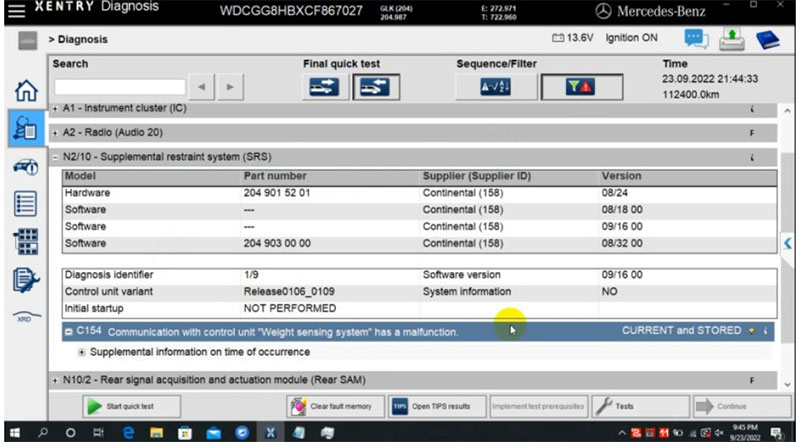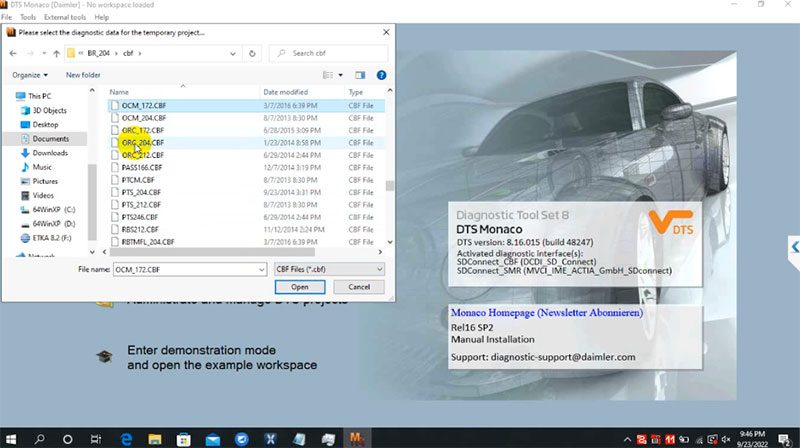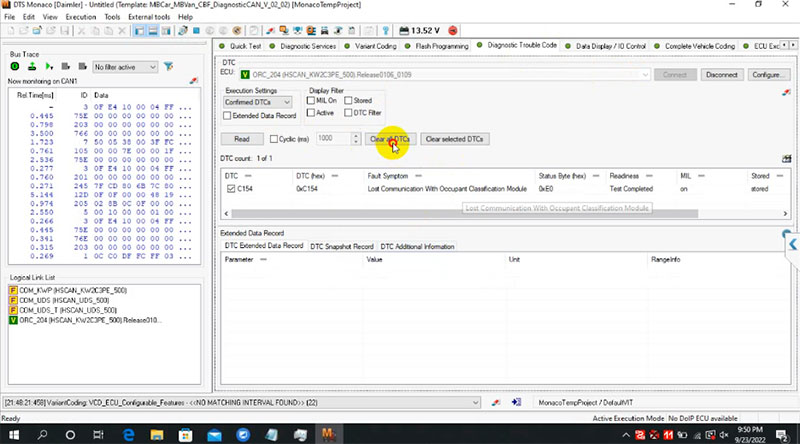The weight sensing system (WSS) in Mercedes-Benz vehicles is a crucial safety feature that plays a vital role in the activation of the passenger seat airbag. By detecting the weight of the occupant, whether a child or adult, it ensures the airbag deploys with the appropriate force or remains inactive. However, this system can sometimes trigger error codes, like the C154 fault code, leading to malfunctions that can disable the airbag in certain situations. For automotive engineers and workshop owners, addressing this issue is essential for maintaining vehicle safety standards.
In this guide, we will dive into understanding the weight sensing system, its function, common malfunctions, and provide a step-by-step guide on how to fix the fault code C154: Communication with control unit ‘weight sensing system’ has a malfunction.
What is the Mercedes-Benz Weight Sensing System?
The weight sensing system, integrated into the passenger seat, helps the vehicle’s control unit determine whether the seat is occupied by an adult or a child. This information is critical for the proper functioning of the airbag. If the system detects a child, it either reduces the airbag’s deployment force or disables it entirely to prevent injuries during a crash.
This system can be found in various Mercedes-Benz models such as the C-Class (W204), E-Class (W211), S-Class (W220), and even models like the CLS, CLK-Class, and ML-Class. Despite being an advanced safety feature, the weight sensing system often encounters faults, leading to the SRS warning light and issues related to the airbag’s proper functioning.

Recognizing Fault Code C154
The most common sign of a malfunction in the weight sensing system is the SRS (Supplemental Restraint System) warning light, which will blink continuously. When performing diagnostics using software like Xentry, this issue is often associated with fault code C154: Communication with control unit ‘weight sensing system’ has a malfunction.
Older Mercedes-Benz vehicles, particularly those produced around the 2000s, are prone to this fault. The root cause of this error often lies in communication problems between the weight sensing system and the vehicle’s control units, especially if updates have been performed incorrectly or if the WSS unit is defective.
How to Fix the Weight Sensing System Fault (C154)
When the weight sensing system fails, the airbag system may be compromised, posing serious safety risks for passengers. The following steps provide a clear solution for fixing the C154 fault code, ensuring the system functions correctly. This process involves coding to deactivate the weight sensing system.
Essential Tools and Software
Before starting the repair process, make sure you have the necessary software and diagnostic equipment ready:
- Vediamo or DTS Monaco (for coding and programming)
- Xentry (for diagnostics)
- Mercedes-Benz C4 Multiplexer (to connect the vehicle to the diagnostic software)
Step-by-Step Guide to Fix the Weight Sensing System
1. Connect Vehicle to Diagnostic Tools:
Start by connecting the vehicle to the Xentry software using the C4 multiplexer. Xentry will read the SRS control unit and identify the error code.

2. Read Error Codes:
Use Xentry to scan for error codes related to the airbag system. The C154 fault code will indicate communication issues with the WSS.
3. Open DTS Monaco for Coding:
After identifying the issue in Xentry, switch to DTS Monaco for coding. This software allows you to modify the control units in the vehicle, including the SRS.
4. Select the CBF File for Coding:
In DTS Monaco, select the appropriate CBF file corresponding to the control unit you need to code. This is essential for communication with the ECU (Electronic Control Unit).

5. Perform Internal Coding:
Access the SRS control unit within DTS Monaco. Modify the Internal Coding section to disable the weight sensing system. This step requires precision, as incorrect coding can lead to further malfunctions.
6. Clear ECU Errors:
Once the coding is complete, use DTS Monaco or Xentry to clear any remaining error codes from the ECU. Ensure that the SRS warning light is no longer blinking.

7. Test the System:
After clearing the errors, perform a system test to verify that the weight sensing system has been successfully disabled and the airbag system is functioning correctly.
By following these steps, you’ll have successfully addressed the C154 fault code, restoring the safety and functionality of the airbag system.

Why Workshop Owners and Automotive Engineers Should Perform This Fix
The weight sensing system plays a crucial role in passenger safety. When it malfunctions, the airbags may not deploy correctly, putting occupants at risk in the event of an accident. Fixing the C154 error ensures that the airbag system functions as intended, protecting the vehicle’s occupants.
Moreover, correctly fixing this issue helps avoid unnecessary airbag recalls and warranty claims, saving both time and money for workshop owners and automotive engineers.
Troubleshooting Tips
- Ensure All Equipment is Up-to-Date:
- Always ensure your diagnostic software is up to date. Outdated versions of Xentry, Vediamo, or DTS Monaco may not communicate properly with the vehicle’s control units, leading to further issues.
- Double-Check Connections:
- If you encounter problems while coding, ensure all connections between the C4 multiplexer and the vehicle are secure. Loose connections can cause incomplete coding, resulting in additional errors.
- Have a Backup Plan:
- Before performing any coding changes, it’s wise to create a backup of the vehicle’s original settings. This way, you can restore the previous configuration if anything goes wrong.
Cardiagtech – Your trustworthy alliance
Dealing with a malfunction in the Mercedes-Benz Weight Sensing System can be tricky and time-consuming without the right tools and expertise. At Cardiagtech, we specialize in resolving complex issues like the C154 fault code with precision and professionalism. Our team of experienced automotive engineers is here to help you restore your vehicle’s safety features with ease.
Don’t risk your safety or your client’s satisfaction by leaving this issue unresolved. Let us take care of it for you! Whether you need coding assistance, diagnostic software, or technical support, we offer remote programming services to ensure your vehicle is back on the road safely and quickly.
Contact us today via WhatsApp at +1 (641) 206-8880 or visit our website to book a consultation. We provide 24/7 support, so you’ll always have a professional ready to guide you through any repair process. Trust Cardiagtech to keep your Mercedes-Benz running at its best!
Q&A Section
Q1: What happens if the weight sensing system malfunctions?
A: If the weight sensing system malfunctions, the SRS warning light will blink, and the passenger seat airbag may be disabled, increasing the risk of injury in the event of a collision.
Q2: Can the weight sensing system be permanently disabled?
A: Yes, through coding with software like DTS Monaco or Vediamo, the weight sensing system can be disabled. However, this should only be done by experienced automotive engineers, as it affects the vehicle’s safety systems.
Q3: Do I need specialized tools to fix this issue?
A: Yes, fixing the C154 fault code requires access to Xentry, DTS Monaco, and the C4 multiplexer to perform diagnostics and coding.
Conclusion
The Mercedes-Benz weight sensing system is a critical component of the vehicle’s airbag safety. Addressing malfunctions like the C154 error code is essential to ensuring passenger safety and compliance with Mercedes-Benz standards. With the right tools and knowledge, automotive engineers and workshop owners can quickly diagnose and fix this issue, restoring the vehicle’s full safety capabilities.

